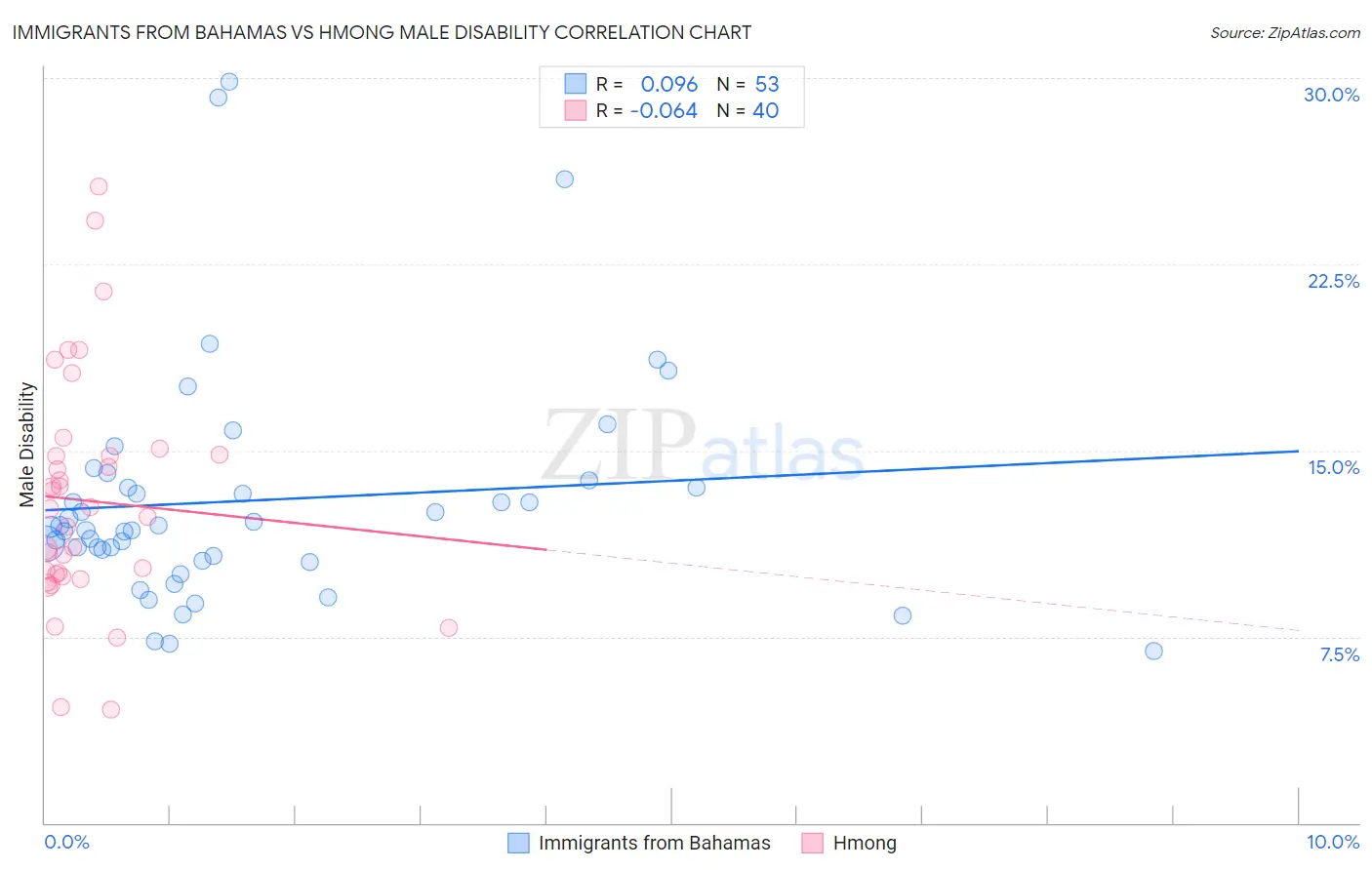Immigrants from Bahamas vs Hmong Male Disability
COMPARE
Immigrants from Bahamas
Hmong
Male Disability
Male Disability Comparison
Immigrants from Bahamas
Hmong
11.7%
MALE DISABILITY
3.2/ 100
METRIC RATING
223rd/ 347
METRIC RANK
12.5%
MALE DISABILITY
0.0/ 100
METRIC RATING
272nd/ 347
METRIC RANK
Immigrants from Bahamas vs Hmong Male Disability Correlation Chart
The statistical analysis conducted on geographies consisting of 104,654,023 people shows a slight positive correlation between the proportion of Immigrants from Bahamas and percentage of males with a disability in the United States with a correlation coefficient (R) of 0.096 and weighted average of 11.7%. Similarly, the statistical analysis conducted on geographies consisting of 24,681,537 people shows a slight negative correlation between the proportion of Hmong and percentage of males with a disability in the United States with a correlation coefficient (R) of -0.064 and weighted average of 12.5%, a difference of 6.2%.

Male Disability Correlation Summary
| Measurement | Immigrants from Bahamas | Hmong |
| Minimum | 6.9% | 4.6% |
| Maximum | 29.9% | 25.6% |
| Range | 23.0% | 21.1% |
| Mean | 13.0% | 13.0% |
| Median | 11.9% | 12.5% |
| Interquartile 25% (IQ1) | 10.7% | 10.0% |
| Interquartile 75% (IQ3) | 13.6% | 14.8% |
| Interquartile Range (IQR) | 3.0% | 4.8% |
| Standard Deviation (Sample) | 4.7% | 4.7% |
| Standard Deviation (Population) | 4.6% | 4.6% |
Similar Demographics by Male Disability
Demographics Similar to Immigrants from Bahamas by Male Disability
In terms of male disability, the demographic groups most similar to Immigrants from Bahamas are Japanese (11.7%, a difference of 0.020%), Liberian (11.8%, a difference of 0.030%), Alsatian (11.7%, a difference of 0.080%), Subsaharan African (11.8%, a difference of 0.15%), and Immigrants from Congo (11.7%, a difference of 0.24%).
| Demographics | Rating | Rank | Male Disability |
| Immigrants | Dominican Republic | 4.9 /100 | #216 | Tragic 11.7% |
| Immigrants | Dominica | 4.6 /100 | #217 | Tragic 11.7% |
| Immigrants | England | 4.0 /100 | #218 | Tragic 11.7% |
| Panamanians | 3.8 /100 | #219 | Tragic 11.7% |
| Immigrants | Western Europe | 3.8 /100 | #220 | Tragic 11.7% |
| Immigrants | Congo | 3.7 /100 | #221 | Tragic 11.7% |
| Alsatians | 3.3 /100 | #222 | Tragic 11.7% |
| Immigrants | Bahamas | 3.2 /100 | #223 | Tragic 11.7% |
| Japanese | 3.1 /100 | #224 | Tragic 11.7% |
| Liberians | 3.1 /100 | #225 | Tragic 11.8% |
| Sub-Saharan Africans | 2.8 /100 | #226 | Tragic 11.8% |
| Austrians | 2.5 /100 | #227 | Tragic 11.8% |
| Hispanics or Latinos | 2.3 /100 | #228 | Tragic 11.8% |
| Bermudans | 2.3 /100 | #229 | Tragic 11.8% |
| Croatians | 2.1 /100 | #230 | Tragic 11.8% |
Demographics Similar to Hmong by Male Disability
In terms of male disability, the demographic groups most similar to Hmong are Native Hawaiian (12.5%, a difference of 0.060%), Hopi (12.5%, a difference of 0.39%), Fijian (12.6%, a difference of 0.75%), African (12.6%, a difference of 0.80%), and Finnish (12.6%, a difference of 1.1%).
| Demographics | Rating | Rank | Male Disability |
| Immigrants | Portugal | 0.1 /100 | #265 | Tragic 12.3% |
| Hawaiians | 0.1 /100 | #266 | Tragic 12.3% |
| Immigrants | Germany | 0.1 /100 | #267 | Tragic 12.3% |
| Portuguese | 0.1 /100 | #268 | Tragic 12.3% |
| Czechoslovakians | 0.1 /100 | #269 | Tragic 12.3% |
| Spaniards | 0.1 /100 | #270 | Tragic 12.3% |
| Scandinavians | 0.1 /100 | #271 | Tragic 12.3% |
| Hmong | 0.0 /100 | #272 | Tragic 12.5% |
| Native Hawaiians | 0.0 /100 | #273 | Tragic 12.5% |
| Hopi | 0.0 /100 | #274 | Tragic 12.5% |
| Fijians | 0.0 /100 | #275 | Tragic 12.6% |
| Africans | 0.0 /100 | #276 | Tragic 12.6% |
| Finns | 0.0 /100 | #277 | Tragic 12.6% |
| Central American Indians | 0.0 /100 | #278 | Tragic 12.7% |
| Slovaks | 0.0 /100 | #279 | Tragic 12.7% |